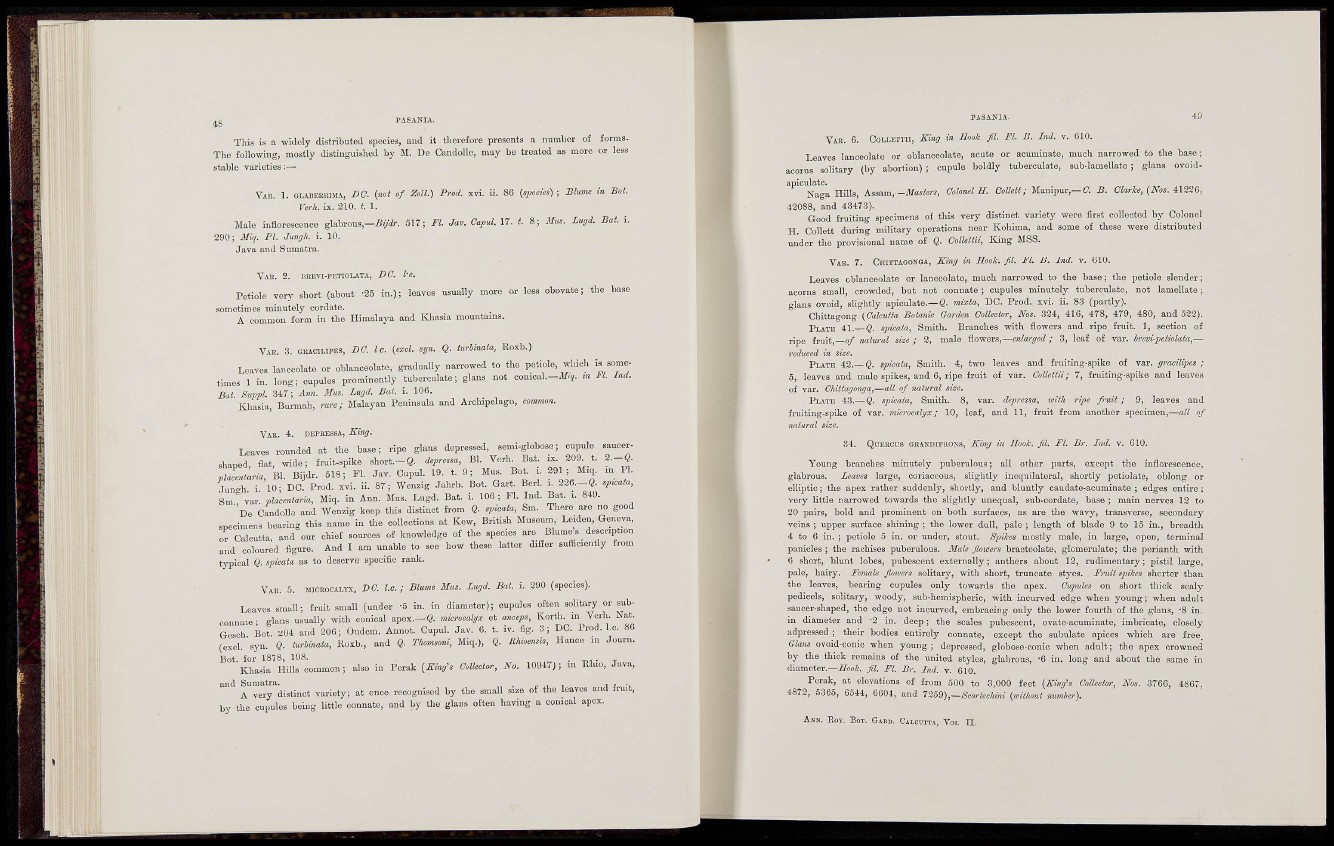
^g l-ASAiMA.
This is a widely distributed species, and it therefore presents a iminber of forms.
The following, mostly distinguished by M. De Candolle, may be treated as more or less
stable varieties:—
Vae. 1. OLABEiiRlMi, DC. (not of ZM.) Prod. xvi. ii. 86 (spicies) ; Blume in Bot.
Verh. ix. 310. i. 1.
Male it,florescence glabrous,—.Bgir. 517; Fl. Jm. Cupul. 17. t. 8; Mm. Lngi. Bat. i.
290; Miq. PI. JunfL i. 10.
Java and Sumatra.
YAR. 2. BEEVI-PETIOLATA, DC. I'C.
Petiole very short (about -ZS in.); leaves usually more or less obovate; the base
sometimes minutely cordate.
A common form in the Himalaya and Khasia mountains.
Vak. 3. GKAOILIPES, DC. I c. (ad. syn. Q. kirUmiti, Roxb.)
Leaves lanceolate or oblaneeolate, gradually narrowed to the petiole, which is sometimes
1 in. long; cupnles prominently tnberoulate; glans not corneal.-»}, m JH. M .
Bat. Suppl. 347; Am. Mm. Lugd. Bat. i. 106.
Khasia, Burmah, rare; Malayan Peninsula and Archipelago, com,mm.
Vab. 4. nEPREssA, King.
Leaves ronnded at the base; ripe glans depressed, semi-globose; cupule saucershaped,
flat, wide; frnit-spike short.-g. deprava, Bl. Verh. Bat. 209^ t. 2.-«.
f l a L t o r i a , Bl. Bljdr. 618; FI. Jav. Cupul. 19. t. 9; Mus. Bot. r. » " i Mrq. m 11.
Jnno-h i 10- DC. Prod. xvi. ii. 87; Wenzig Jatob. Boi. Gart. Beri. i. 2 2 6 . - e . ¡peata,
Sm ! var: Miq. in Ann. Mus. Lugd. Bat. i. 106 ; Fl. Ind. Bat. i. 840.
De Candolle and Wenzig keep tiri, distinct from Q. >picata, Sm. There are no good
specimens bearing this name in the collections at Kew, British Museum Leiden, Geneva,
or Calcutta, and onr chief sources of knowledge of the species are Bluu.es desenption
end coloured figure. And I am unable to see how these ktter difler sufficiently from
typical Q. spicata as to deserve specific rank.
Vak. 5. MICROCAI.K, DC. i.e.; Blum, Mus. Lugd. Bat. i. 290 (species).
Leaves small; fruit small (under -5 in. in diameter); cupnles often solitary or subconnate
glans usually with conical apex.-C. rmrocala^ et aneqis, Korth. in Verh. Nat.
Gesch Bot. - M and 206; Ondem. Annot. Cupul. Jav. 6. t. iv. fig. 3; DO. Prod. 1 c. 86
(exel. syn. Q. turUnala, Hoib., and Q. Tlumsam, Miq.), Q. Rhioenm, Hance m Journ.
Bot. for 1878, 198. . . ,
Khasia Hills common; also in Perak (King's CMeclor, No. 10947); m Ehio, Java,
^""e^y'distinct variety; at once recognised by the small si^e of the leaves and fruit,
by the cupules being little connate, and by the glans often having a conical apex.
Yar. 6. CoLlETTll, King in Hook. fil. Fl. B. Ind. v. 610.
„„.„J lanceolate or oblaneeolate, acute or acuminate, much narrowed to the base;
acorns solitary (by abortion) ; cupule boldly tubereulate, sub-lamellate ; glans ovoidapicukte^
Hills, kssxm,—Masters, Colonel E. Collett; Manipur,—C. B. Olarb, (Nas. 4,1226,
42088, and 43473). , , „ , ,
Good fruiting specimens of this very distmct variety were first collected by Colonel
H. Collett during military operations near Kohima, and some of these were distributed
under the provisional name of Q. Cottettii, King MSS.
Vak. 7. Csittaoohga, King in Book. fil. Fl. B. Jni. v. 610.
Leaves cblaneeolate or lanceolate, much narrowed to the base; the petiole slender;
acorns small, crowded, but not connate ; eupules minutely tubercniate, not lamellate;
glans ovoid, slightly apiculate.—5. mixta, DC. Prod. xvi. ii. 83 (partly).
Chittagong (Calcutta Botanic Oarden Oolleetor, Ms. 324, 416, 478, 479, 480, and 522).
P l a t e 41.— Q. spicata. Smith. Branches with flowers and ripe fruit. 1, section of
ripe fruit,—»/ natural size ; 2, male flowers,—EWTO-F/ERF; 3, leaf of var. Irevi-petiolata,—
P l a t e 42.—Q. spieata, Smith. 4, two leaves and fi-uiting-spike of var. .
5, leaves and male spikes, and 6, ripe fruit of var. ColUttii; 7, fruiting-spike and leaves
of var. CUttagonga,—all of natural size.
Pl.ate 43.—Q. spicata, Smith. 8, var. depressa, with ripe fl-uit; 9, leaves and
fruiting-spike of var. microcalgx; 10, leaf, and 11, fruit from another specimen,—all of
natural size.
34. Quekcus GRANDlFiiONs, King in Hook. fil. Fl. Br. Ind. v. 010.
Young branches minutely puberulous; all other parts, except the inflorescence,
glabrous. Leaves large, coriaceous, slightly inequilateral, shortly petiolate, oblong or
elliptic; the apex rather suddenly, shortl}^ and bluntly caudate-acuminate ; edges entii-e ;
very little narrowed towards the slightly unequal, sub-cordate, base ; main nerves 12 to
20 pairs, bold and prominent on both surfaces, as are the wavy, transverse, secondary
veins ; upper surface shining ; the lower dull, pale ; length of blade 9 to 15 in., breadth
4 to 6 in. ; petiole 5 in. or under, stout. Spikes mostly male, in large, open, terminal
panicles ; the rachises puberulous. Male fiowers bracteolate, glomerulate; the perianth with
6 short, blunt lobes, pubescent externally; anthers about 12, rudimentary; pistil large,
pale, hairy. Female Jlowei-s solitary, with short, truncate styes. Fruit spikes shorter than
the leaves, bearing eupules only towards the apex. Cupules on short thick scaly
pedicels, solitary, woody, sub-hemispheric, with incurved edge when young; when adult
saucer-shaped, the edge not incurved, embracing only the lower fom-th of the glans, -8 in.
in diameter and -2 in. deep; the scales pubescent, ovate.acuminate, imbricate, closely
adpi-essed ; their bodies entirely connate, except the subulate apices which are free,
Glam ovoid-conic when young ; depressed, globose-conic -when adult; the apex crowned
by the thick remains of the united styles, glabrous, -6 in. long and about the same in
diameter.—Hook. fil. Fl. Br. Ind. v. 610.
Perak, at elevations of from 600 to 3,000 feet (King's Collector, Nos. 3766, 4867,
4872, 5365, 6544, 6604, and 't2ad),—Scortechim {without number).
Asn. Eoy. Bot. Gai • CALCurrA, Yoi, II.